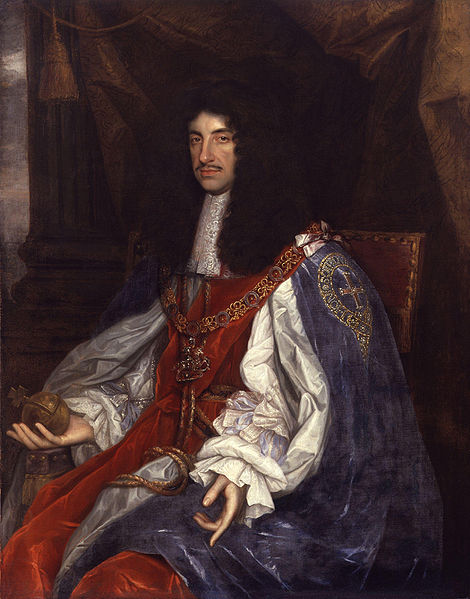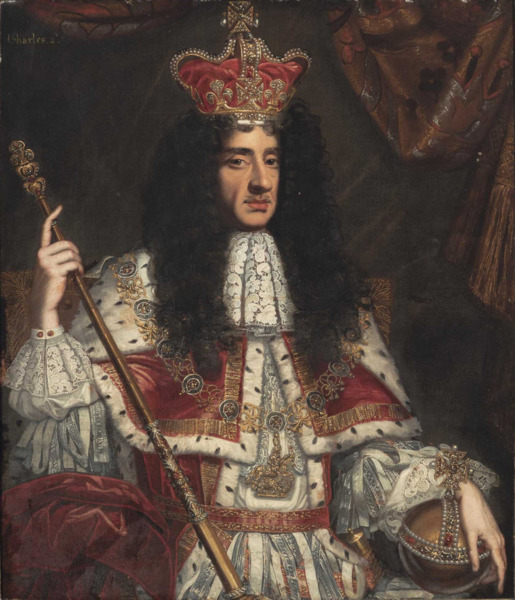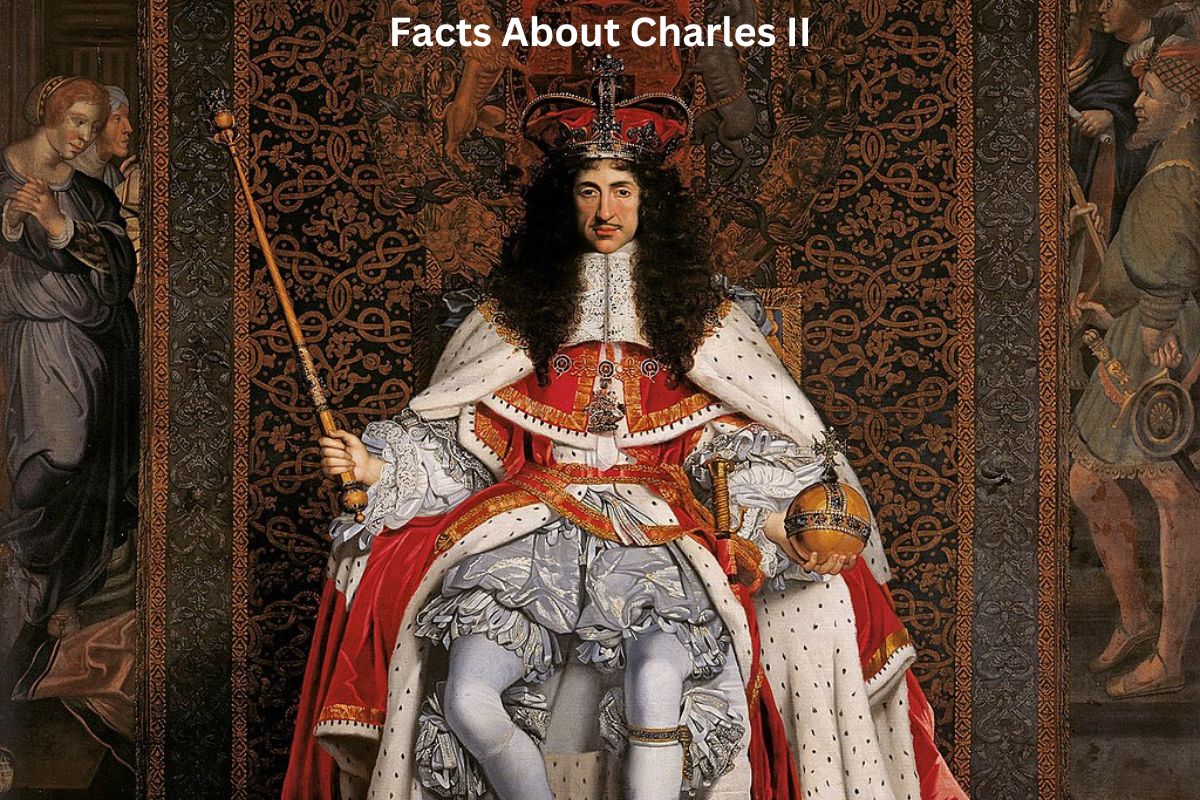Charles II, born on May 29, 1630, in London, was the son of King Charles I and Queen Henrietta Maria. After a period of exile in France, he returned to England in 1660, following the Restoration, to become the King of England, Scotland, and Ireland.
His reign, known as the Restoration Period, saw the reopening of theaters, a return to monarchy, and cultural revival. Challenges included the Great Fire of London in 1666 and the Popish Plot conspiracy.
Charles II established the Royal Society in 1660, promoting scientific inquiry. He died on February 6, 1685, succeeded by his brother James II.
The Glorious Revolution of 1688, driven by concerns over James II’s Catholicism, reshaped English governance and marked the beginning of constitutional monarchy.
Charles II’s legacy is one of restoration, cultural renewal, and laying the groundwork for constitutional changes in England.
Charles II Facts
1. Restored the English monarchy in 1660
Charles II played a pivotal role in the restoration of the English monarchy after a period of political turmoil and civil war. Following the execution of his father, Charles I, in 1649, the monarchy was abolished, and England was declared a Commonwealth.
Also Read: English Civil War Timeline
Charles spent the next decade and a half in exile, mostly in France. In 1660, following the death of the Lord Protector Oliver Cromwell and the collapse of the Commonwealth, Charles was invited to return to England and assume the throne.
His restoration marked the end of the Interregnum and the reestablishment of the Stuart monarchy.

2. Spent much of his exile in France
After his father’s execution, Charles II went into exile to escape the political turmoil in England. He initially sought refuge in the Dutch Republic and later spent a significant portion of his exile in France.
Also Read: Accomplishments of Charles II
In France, he lived at the court of Louis XIV, the Sun King, and was influenced by the opulent French culture of the time. During his exile, Charles II made several unsuccessful attempts to regain the English throne, including the famous Royalist uprising known as the Royalist War in Ireland in 1650.
3. Reigned during the Restoration Period
Charles II’s reign is closely associated with the Restoration Period, which lasted from 1660 to 1685. This period was characterized by a return to monarchical rule, the reestablishment of the Church of England as the state religion, and a general atmosphere of social and cultural revival.
The Restoration also marked the reopening of theaters, including the famous London playhouses, which had been closed during the Commonwealth period. This era saw a resurgence of English drama and literature, with playwrights like John Dryden and poets like Samuel Pepys contributing to the cultural landscape.
The period was also known for its relaxed and hedonistic lifestyle, earning Charles II the nickname “Merry Monarch” for his personal enjoyment of entertainment, including the theater and the arts.
4. His reign saw the Great Fire of London in 1666
During Charles II’s reign in 1666, London experienced a devastating event known as the Great Fire of London.
The fire started on September 2nd and raged for three days, destroying a significant portion of the city, including thousands of homes and many prominent buildings, such as St. Paul’s Cathedral.
Although the fire was a tragedy that left tens of thousands of Londoners homeless, it also had some positive consequences.
The destruction paved the way for modern urban planning, including the construction of wider streets and buildings made of brick and stone rather than timber, which helped prevent future catastrophic fires.
5. Dissolved the Cavalier Parliament in 1679
The Cavalier Parliament was a loyalist and royalist-dominated English Parliament that had supported Charles II’s restoration to the throne in 1660.
However, by 1679, tensions were growing over issues such as the succession to the throne due to Charles’s lack of legitimate heirs and his brother James, Duke of York, being a Roman Catholic.
In response to this and to mitigate the Exclusion Crisis (efforts to exclude James from the line of succession), Charles II dissolved the Cavalier Parliament. This marked a significant political move during his reign and led to further political instability.

6. Signed the Treaty of Dover with Louis XIV in 1670
In 1670, Charles II signed the Treaty of Dover with King Louis XIV of France. This secret treaty had both political and religious components.
Politically, it committed Charles to support Louis in his conflict with the Dutch Republic (the Third Anglo-Dutch War), in exchange for French financial assistance. Religiously, the treaty included a clause where Charles II agreed to publicly convert to Catholicism or at least make concessions to Catholics.
This agreement was highly controversial, as England had a history of religious conflict and tensions between Catholics and Protestants. Charles’s perceived leanings toward Catholicism contributed to the rising anti-Catholic sentiment and the Popish Plot conspiracy that emerged later in his reign.
7. Faced the Popish Plot conspiracy
The Popish Plot was a fictitious conspiracy theory that emerged during Charles II’s reign, primarily in the late 1670s and early 1680s. It alleged that there was a secret Catholic conspiracy to assassinate the king and overthrow the Protestant government.
The most infamous figure associated with the plot was Titus Oates, who fabricated stories about a Catholic plot. These accusations led to the persecution and execution of several innocent Catholics and fueled anti-Catholic sentiment in England.
Charles II’s handling of the Popish Plot was marked by skepticism, as he doubted the credibility of the accusations. Nevertheless, the hysteria surrounding the plot had a significant impact on English politics and society during this period.
8. Played a role in founding the Royal Society
Charles II played a pivotal role in the establishment of the Royal Society of London for Improving Natural Knowledge, commonly known as the Royal Society.
Founded in 1660, this scientific organization aimed to promote scientific inquiry and collaboration. Charles II granted the society a royal charter in 1662, giving it official recognition and support.
The Royal Society became a focal point for scientific innovation and exploration during the 17th century, fostering advancements in various fields, including astronomy, physics, and biology. Prominent scientists like Robert Boyle and Isaac Newton were associated with the Royal Society.
9. Died in 1685, succeeded by James II
Charles II died on February 6, 1685, bringing an end to his 25-year reign. He died without legitimate heirs, and his brother, James, Duke of York, succeeded him as James II. This transition of power marked a significant turning point in English history.
James II’s Catholicism and his efforts to promote Catholic interests led to increased tension between the monarchy and Parliament, eventually culminating in the Glorious Revolution of 1688.
10. His reign ended with the Glorious Revolution in 1688
Charles II’s reign indirectly contributed to the Glorious Revolution of 1688. The controversial policies of his brother James II, including efforts to expand Catholicism’s influence, alienated many Protestant nobles and parliamentarians.
In 1688, a group of English nobles invited William of Orange, a Protestant Dutch prince and James II’s son-in-law, to invade England and protect Protestantism. This event, known as the Glorious Revolution, resulted in James II’s abdication and the ascent of William and Mary to the throne.
It also led to the adoption of the English Bill of Rights and the establishment of constitutional limitations on the monarchy, further shaping the course of English governance.
